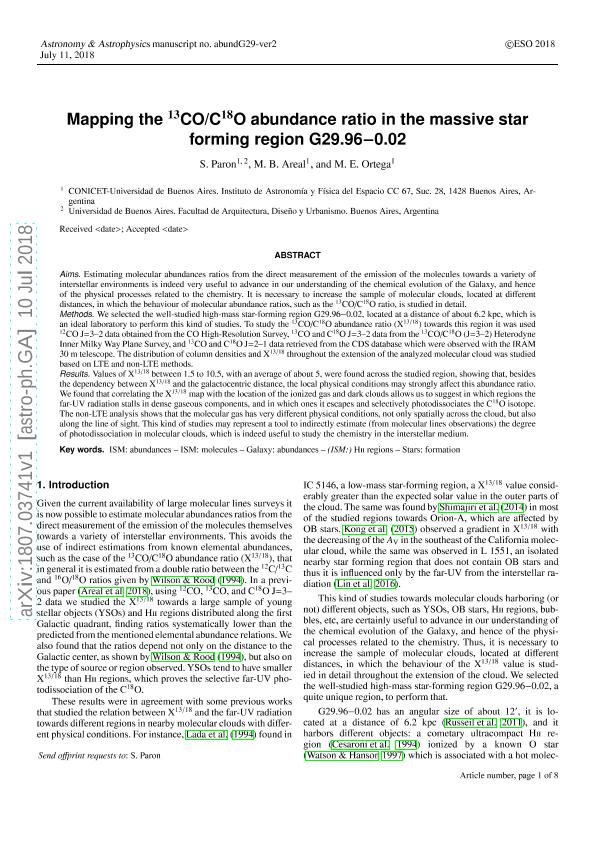Artículo
Mapping the 13CO/C18O abundance ratio in the massive star-forming region G29.96-0.02
Fecha de publicación:
09/2018
Editorial:
EDP Sciences
Revista:
Astronomy and Astrophysics
ISSN:
0004-6361
Idioma:
Inglés
Tipo de recurso:
Artículo publicado
Clasificación temática:
Resumen
Aims. Estimating molecular abundances ratios from directly measuring the emission of the molecules toward a variety of interstellar environments is indeed very useful to advance our understanding of the chemical evolution of the Galaxy, and hence of the physical processes related to the chemistry. It is necessary to increase the sample of molecular clouds, located at different distances, in which the behavior of molecular abundance ratios, such as the 13CO/C18O ratio, is studied in detail. Methods. We selected the well-studied high-mass star-forming region G29.96-0.02, located at a distance of about 6.2 kpc, which is an ideal laboratory to perform this type of study. To study the 13CO/C18O abundance ratio (X13/18) toward this region, we used 12CO J = 3-2 data obtained from the CO High-Resolution Survey, 13CO and C18O J = 3-2 data from the 13CO/C18O (J = 3-2) Heterodyne Inner Milky Way Plane Survey, and 13CO and C18O J = 2-1 data retrieved from the CDS database that were observed with the IRAM 30 m telescope. The distribution of column densities and X13/18 throughout the extension of the analyzed molecular cloud was studied based on local thermal equilibrium (LTE) and non-LTE methods. Results. Values of X13/18 between 1.5 and 10.5, with an average of about 5, were found throughout the studied region, showing that in addition to the dependency of X13/18 and the galactocentric distance, the local physical conditions may strongly affect this abundance ratio. We found that correlating the X13/18 map with the location of the ionized gas and dark clouds allows us to suggest in which regions the far-UV radiation stalls in dense gaseous components, and in which regions it escapes and selectively photodissociates the C18O isotope. The non-LTE analysis shows that the molecular gas has very different physical conditions, not only spatially throughout the cloud, but also along the line of sight. This type of study may represent a tool for indirectly estimating (from molecular line observations) the degree of photodissociation in molecular clouds, which is indeed useful to study the chemistry in the interstellar medium.
Archivos asociados
Licencia
Identificadores
Colecciones
Articulos(IAFE)
Articulos de INST.DE ASTRONOMIA Y FISICA DEL ESPACIO(I)
Articulos de INST.DE ASTRONOMIA Y FISICA DEL ESPACIO(I)
Citación
Paron, Sergio Ariel; Areal, María Belén; Ortega, Martin Eduardo; Mapping the 13CO/C18O abundance ratio in the massive star-forming region G29.96-0.02; EDP Sciences; Astronomy and Astrophysics; 617; A14; 9-2018; 1-8
Compartir
Altmétricas




